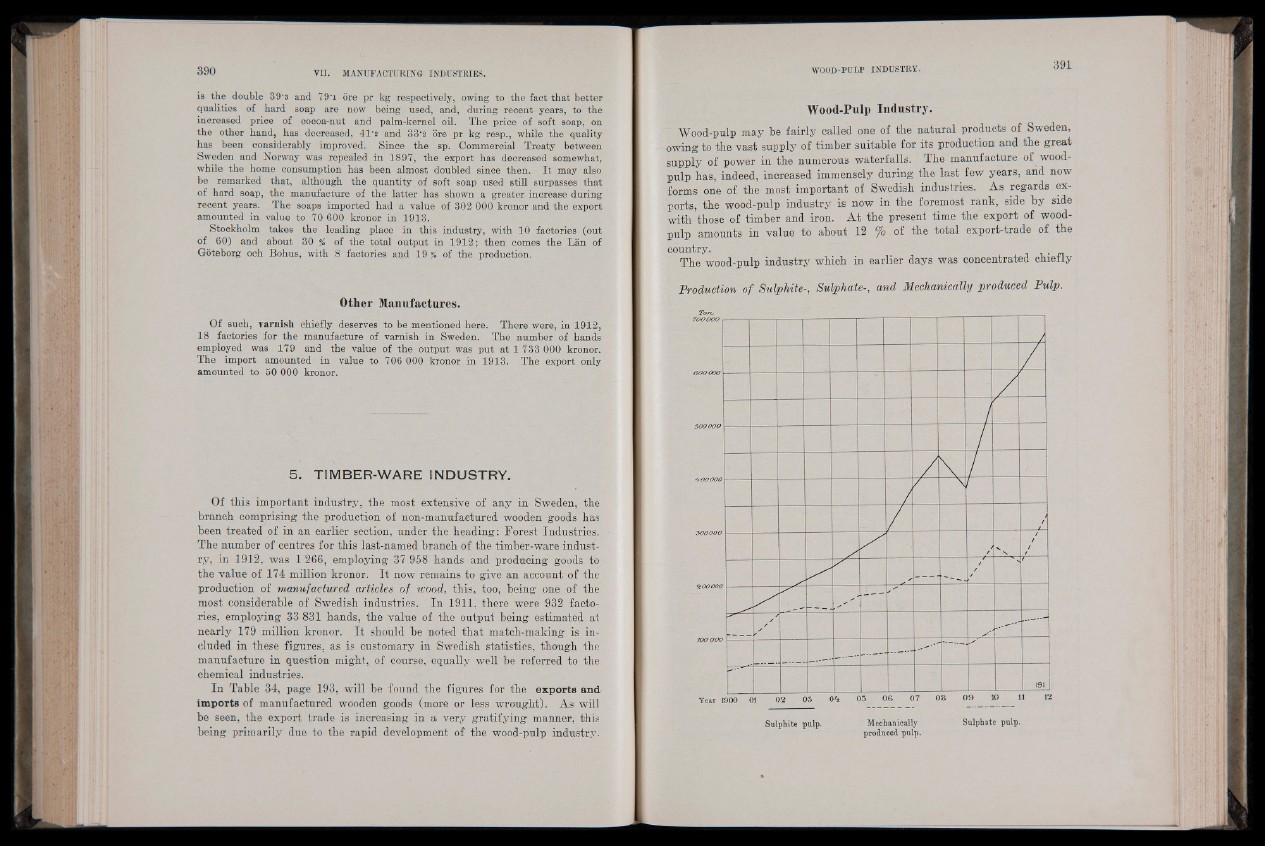
is the double 39-s and 79-i ore pr kg respectively, owing to the fact that better
qualities of hard soap are now being used, and, during recent years, to the
increased price of cocoa-nut and palm-kernel oil. The price of soft soap, on
the other hand, has decreased, 4Ta and 33-s ore pr kg resp., while the quality
has been considerably improved. Since the sp. Commercial Treaty between
Sweden and Norway was repealed in 1897, the export has decreased somewhat,
while the home consumption has been almost doubled since then. It may also
be remarked that, although the quantity of soft soap used still surpasses that
of hard soap, the manufacture of the latter has shown a greater increase during
recent years. The soaps imported had a value of 302 000 kronor and the export
amounted in value to 70 600 kronor in 1913.
Stockholm takes the leading place in this industry, with 10 factories (out
of 60) and about 30 % of the total output in 1912; then comes the Län of
Göteborg oeh Bohus, with 8 factories and 19% of the production.
Other Manufactures.
Of such, varnish chiefly deserves to be mentioned here. There were, in 1912,
18 factories for the manufacture of varnish in Sweden. The number of hands
employed was 179 and the value of the output was put at 1 733 000 kronor.
The import amounted in value to 706 000 kronor in 1913. The export only
amounted to 50 000 kronor.
5 . TIMBER-WARE INDUSTRY.
Of this important industry, the most extensive of any in Sweden, the
branch comprising the production of non-manufactured wooden goods has
been treated of in an earlier section, under the heading; Forest Industries.
The number of centres for this last-named branch of the timber-ware industry,
in 1912, was 1 266, employing 37 958 hands and producing goods to
the value of 174 million kronor. It now remains to give an account of the
production of manufactured articles of wood, this, too, being one of the
most considerable of Swedish industries. In 1911, there were 932 factories,
employing 33 831 hands, the value of the output being estimated at
nearly 179 million kronor. It should be noted that match-making is included
in these figures, as is customary in Swedish statistics, though the
manufacture in question might, of course, equally well be referred to the
chemical industries.
In Table 34, page 193, will be found the figures for the exports and
imports of manufactured wooden goods (more or less wrought). As will
be seen, the export trade is increasing in a very gratifying manner, this
being primarily due to the rapid development of the wood-pulp industry.
Wood-Pulp Industry.
Wood-pulp may be fairly called one of the natural products of Sweden,
owing to the vast supply of timber suitable for its production and the great
supply of power in the numerous waterfalls. The manufacture of wood-
pulp has, indeed, increased immensely during the last few years, and now
forms one of the most important of Swedish industries. As regards exports,
the wood-pulp industry is now in the foremost rank, side by side
with those of timber and iron. At the present time the export of wood-
pulp amounts in value to about 1 2 °/o of the total export-trade of the
country. -y y ‘ .
The wood-pulp industry which in earlier days was concentrated chiefly
Production of Sulphite-, Sulphate-, and Mechanically produced Pulp.
Year 1900 01 02 03 0 4 05 06 07 OS 0 9 10 11 12
Sulphite pulp. Mechanically Sulphate pulp,
produced pulp.